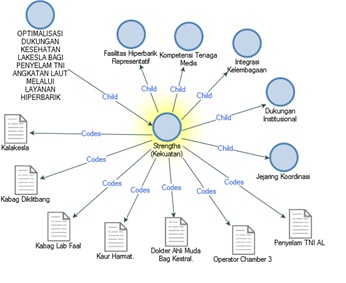Optimizing Lakesla Health Support for Indonesian Navy Divers Through Hyperbaric Services: An Analysis of Challenges and Strategies to Support the Main Tasks of the Indonesian Navy
Abstract
Navy divers of the Indonesian Navy face serious health risks due to activities in extreme pressure environments, such as decompression and gas embolism. As a naval military health institution, Lakesla holds a strategic role in providing hyperbaric therapy to ensure divers’ readiness and safety. This study analyzes three main aspects: challenges in the implementation of hyperbaric services, their contribution to operational readiness and diver safety, and optimization strategies to sustainably support the main tasks of the Indonesian Navy. The research employs a qualitative approach through in-depth interviews, field observations, and documentation, with data analysis conducted using NVivo software, triangulation, and a SWOT framework enhanced by the IFAS–EFAS matrix. The findings indicate that Lakesla has strengths in representative hyperbaric facilities, competent medical personnel, and institutional support from the Navy, yet faces constraints in certified human resources, limited equipment maintenance budgets, and suboptimal information systems. External opportunities, including increased diving operations, technological advancements, and potential inter-institutional cooperation, outweigh existing threats, positioning Lakesla in Quadrant I (aggressive strategy). Hyperbaric services have been proven to significantly contribute to the readiness and safety of Navy divers. Optimization can be achieved through integrating services within Navy operational systems, strengthening human resource competence, digitalizing diver medical records, and enhancing research and educational outreach. With these strategies, Lakesla has the potential to evolve into a modern, adaptive, and sustainable center of excellence in diving medicine.
References
E. Fitriasari, N. K. Sri Dewi Untari, and N. Annisa Fitra, “Risk Factors for Decompression Sickness,” J. Multidisiplin Indones., vol. 3, no. 2, pp. 3806–3818, 2024, doi: 10.58344/jmi.v3i2.1095.
E. Martha, H. Lestari, R. S. Zulfa, and Y. Sopamena, “National health insurance scheme: Internal and external barriers in the use of reproductive health services among women,” Kesmas, vol. 16, no. 2, pp. 91–99, 2021, doi: 10.21109/KESMAS.V16I2.3712.
L. Sadeli, B. Bachtiar, and F. Septiadi, “Physical Fitness Survey of Members of the Communication and Electronics Service of the Indonesian Navy Headquarters,” J. Coach. Educ. Sport., vol. 5, no. 2, pp. 351–359, 2024, doi: 10.31599/yek40889.
K. M. Arifin, I. Irmaleny, S. Sitam, and K. Setiawan, “Dental health status assessment of Indonesian National Military-naval force officers using DMFT index and chief of naval staffrRegulation: a descriptive study,” Padjadjaran J. Dent., vol. 35, no. 3, pp. 253–258, 2023, doi: 10.24198/pjd.vol35no2.49787.
I. Susilo, A. Devi, and A. Purwandhono, “effects of hyperbaric oxygen therapy in improvement of Tnf- Α, Hsp 70, Enos, Vegf, collagen 3, and Il 6 protein expression in wound healing,” Int. J. Health Sci. (Qassim)., vol. 6, no. April, pp. 6907–6916, 2022, doi: 10.53730/ijhs.v6ns4.11374.
R. Holy et al., “The use of hyperbaric oxygen therapy and corticosteroid therapy in acute acoustic trauma: 15 years’ experience at the czech military health service,” Int. J. Environ. Res. Public Health, vol. 18, no. 9, pp. 1–10, 2021, doi: 10.3390/ijerph18094460.
Jusmawati, A. A. Arsin, and F. Naiem, “Faktor Risiko Kejadian Decompression Sickness pada Masyarakat Nelayan Peselam Tradisional Pulau Saponda,” J. Mkmi, vol. 12, no. 2, pp. 63–69, 2016.
S. R. Widyastuti, S. Hadisaputro, and M. Munasik, “Berbagai Faktor yang Berpengaruh Terhadap Kualitas Hidup Penyelam Tradisional Penderita Penyakit Dekompresi,” J. Epidemiol. Kesehat. Komunitas, vol. 4, no. 1, p. 45, 2019, doi: 10.14710/jekk.v4i1.4429.
L. Rosyanti, I. Hadi, D. Y. S. Rahayu, and A. B. Birawida, “Mekanisme yang Terlibat dalam Terapi Oksigen Hiperbarik: theoritical review hyperbaric oxygen therapy/HBOT,” Heal. Inf. J. Penelit., vol. 11, no. 2, pp. 180–202, 2019, doi: 10.36990/hijp.v11i2.144.
D. E. P. Djatiwidodo, “Hyperbaric Oxygen Therapy as Adjuvant Therapy in Nasopharyngeal Cancer : A Literature Review,” Surabaya Biomed. J., vol. 2, no. 2, pp. 131–139, 2023, doi: 10.30649/sbj.v2i2.112.
K. Kusnanto, L. R. Wabula, B. Purwanto, H. Arifin, and Y. Kurniawati, “Safety behaviour and healthy diving: A qualitative study in the traditional diverse fishermen,” Int. Marit. Health, vol. 71, no. 1, pp. 56–61, 2020, doi: 10.5603/IMH.2020.0012.
K. Roy, K. K. Maramraj, S. Kumar, A. Sarin, and M. S. Honwad, “Optimizing Quality Assurance in Naval Hospitals: A Qualitative Study by Comprehensive Strength, Weakness, Opportunity, and Threat Analysis,” J. Mar. Med. Soc., pp. 1–6, 2025, doi: 10.4103/jmms.jmms_175_24.
D. Y. Bagaskara and R. Rohmadi, “Analisis pemetaan media tentang pembiayaan rahn di Indonesia dengan NVivo : Studi literatur review,” J. Manag. Digit. Bus., vol. 4, no. 1, pp. 1–14, 2024, doi: 10.53088/jmdb.v4i1.811.







